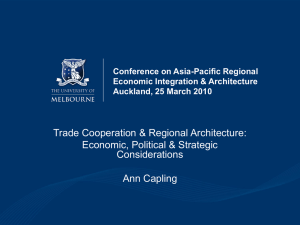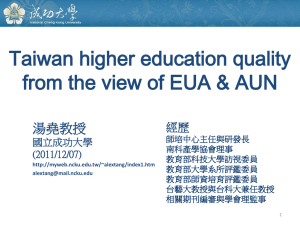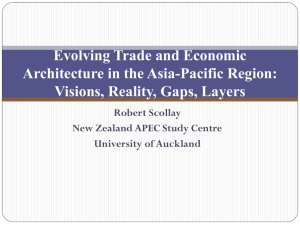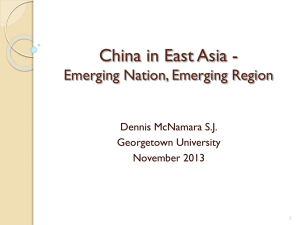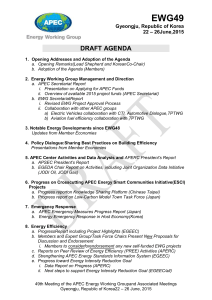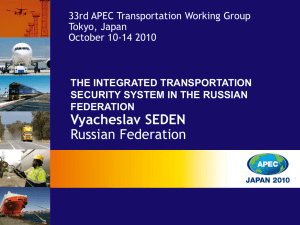National Security - US-Global
advertisement
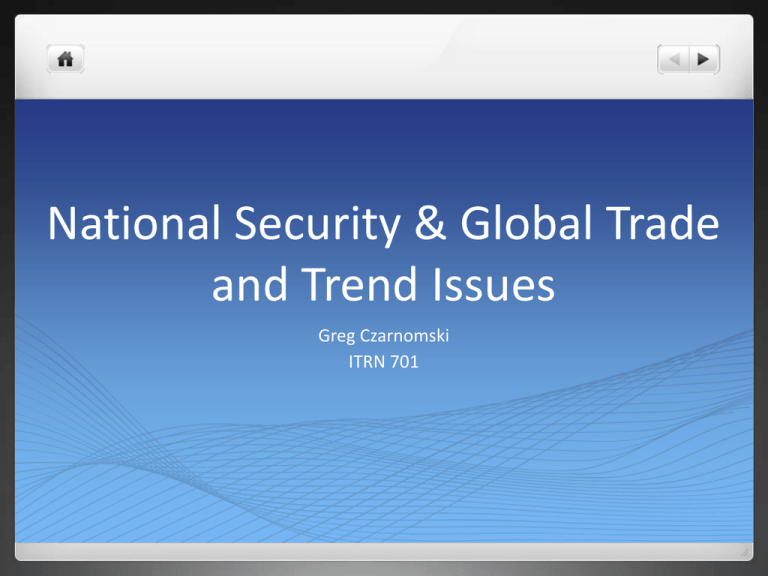
National Security & Global Trade and Trend Issues Greg Czarnomski ITRN 701 Agenda Overview Major Issues US National Interest US Policy Problem Policy Proposal Conclusion Q&A Overview CHINA US, China S&ED (Strategic and Economic Dialogue) 1st rnd July 2009 Issues concerning the South China Sea China’s concern over US troop presence in Australia Trade – APEC US export restrictions on high technology Overview – Major Issues Our pivot in policy towards Asia (policy posture) = “Shift in Posture” China’s agression in S.China Sea (2010) – maritime security PRC Navy ship harrassed a US Navy Ship in intnl waters in the S.China Sea Relationship w/ India, PI, Singapore (ASEAN / APEC) US troops in Australia As these economies develop and the US engages them in trade, it concerns China as their regional neighbors align themselves w/ each other and the US Other nations developing relationship w/ China outside of ASEAN/APEC lanes Cont’d China’s fast economic development is enabling there military development exponentially North Korea, Russia. – This raises concerns over resources primarily The PRC military and IC have consistently made attempts to steal/procure US military secrets and High Technology Our economies are linked,(biggest trade partner) so our development and economic strength is tied to there development – this can be considered a positive Cont’d China wanting more access to purchase out High Technology Aggressive tactics in S. China Sea is a response to attempting to secure resources to fuel its own economy -(legitimate), but possibly also its military - (concerning) US National Interest SOUTH CHINA SEA China’s claim to “ All of it” – Intimidating and harassing its neighboring countries who are also exploring oil drilling opportunities Restrictions on shipping lanes hinder trade ASEAN member countries appealed to US for assistance, the US has engaged China in talks about territorial disputes and has ramped up presence of the Navy On her way to the ASEAN-sponsored East Asia Summit in November, Clinton met with her Philippine counterpart aboard the USS Fitzgerald to reiterate America's support for its ally. - http://www.voanews.com/english/news/asia/South-China-Sea-DisputesTop-Regional-Security-Concerns-135950433.html US Policies / Actions President Barack Obama said good ties between the United States and China are essential and help the rest of the world. Obama welcomed Chinese Vice President Xi Jinping. (Feb. 14 2012) Meeting Vice-President Xi Jinping in the Oval Office, Mr Obama also said it was "vital" that Washington maintained a strong relationship with Beijing. http://www.youtube.com/watch?v=DUVhdz823UM&feature=relmfu Increased US Naval presence in S. China Sea Troop build up in N. Australia "We are making sure that our collective defense capabilities and communications infrastructure are operationally and materially capable of deterring provocation,” Secretary Clinton aboard the USS Fitzgerald w/ PI counterpart on their way to the ASEAN conference in Jakarta Ideas for Policy direction Military presence in the region is pragmatic and legitimate, but needs to be tempered while lanes of communication are kept open w/ China officials. Recent talks have been most encouraging (the Chinese VP’s visit) ,- need to continue. Policy makers need to be looking 15-20 years down the road for long term growth and relationships Its worth noting that the Marine’s arrival in Australia is part of a strategic force realignment. As Marines draw down in Okinawa they are being relocated to Australia where they can assist w/ regional security concerning the growing SE Asia terrorism threat. The nations have converging interests economically that should be able to be resolved w/ out military action. Conclusion Agree w/ General Hayden, China is not to be feared, as it’s economy grows it becomes more intertwined w/ ours and the Global community’s. This relationship should be managed and cultivated through open talks and bi- and multi- leveled agreements concerning the region. Invitations to participate in regional talks and APEC would win trust and be looked upon favorably by China officials China’s Naval maneuvering in S.China Sea are more about and the US’s resent military presence is just posturing. – Both nations know that escalation is unwanted and unnecessary. I think we’ll continue to see more Bi-lateral talks and collaboration concerning trade issues that will be beneficial to both nations Sources http://www.google.com/imgres? http://www.chinaustradelawblog.com/uploads/image/US-and-China. http://www.youtube.com/watch?v=i2c8L5XwCvI&feature=relatedhttp://ww w.chinadaily.com.cn/china/2011sinousdialogue/201105/10/content_12475840.htm http://www.voanews.com/english/news/asia/South-China-Sea-DisputesTop-Regional-Security-Concerns-135950433.html http://www.chinadaily.com.cn/cndy/2011-11/09/content_14061219.htm Q&A


